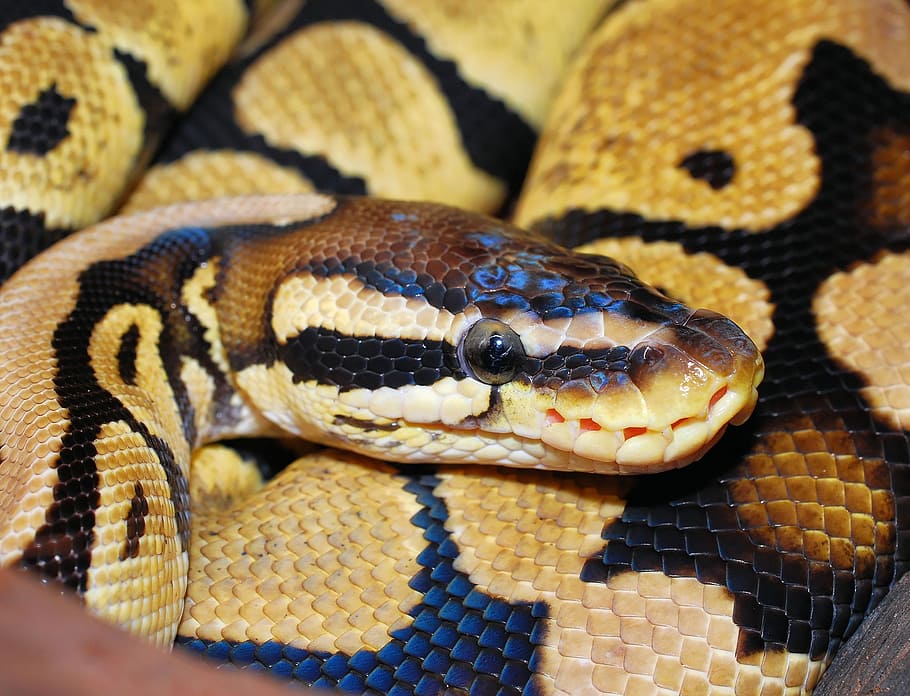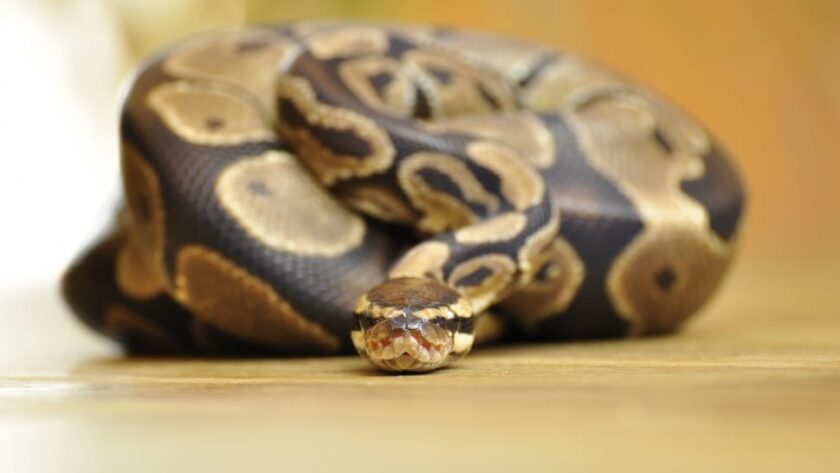Imagine your ball python as a wild predator, stalking its prey through the grasslands of Africa. With lightning-fast reflexes, it strikes, constricts, and devours its meal, providing the nutrients it needs to survive.
Now, imagine bringing that same predator into your home, where it relies on you to provide its food. Feeding your ball python requires attention to detail, knowledge of their natural feeding habits, and a commitment to providing a healthy diet.
In this article, we will explore the tips, schedules, and diets necessary to keep your ball python healthy and nourished. From understanding their feeding habits to avoiding common mistakes, we will guide you through the process of feeding your ball python with confidence.
Whether you’re a new snake owner or a seasoned pro, this article will provide you with the information you need to keep your pet happy and thriving. So, let’s dive into the world of ball python feeding and discover how to provide your snake with the best possible diet.
Table of Contents
Key Takeaways
- Ball pythons are carnivores that feed on small mammals and birds, and can go for long periods of time without eating.
- Feeding charts are essential tools for ball python owners and should vary based on size, sex, and age of the snake.
- Feeding pre-killed prey is safer and more convenient for snake keepers, and feeding should be done outside of the enclosure to avoid behavioral problems.
- Common feeding mistakes include overfeeding, feeding inside the enclosure, handling after feeding, power feeding, and unnecessary supplements, which can all lead to health problems for the snake.
Ball Python Feeding Habits

You’ll be interested to know that ball pythons are carnivorous and have a preference for African giant rats, black rats, grass mice, weaver birds, and rufous-nosed rats. These prey preferences make them effective pest controllers in their native African habitat.
Ball pythons use their heat-sensing pits to locate and capture their prey. They then constrict their prey, which suffocates them before they are swallowed whole.
Feeding frequency for ball pythons varies based on their age and size. Hatchlings can be started off with pinky mice, while juveniles need to eat a small mouse or fuzzy rat every week.
Despite their preference for certain types of prey, ball pythons can go for long periods of time without eating. It’s important to monitor their feeding habits and body score to avoid overfeeding or underfeeding.
Ball Python Feeding Charts and Guidelines
Defrosting frozen prey in the refrigerator for five hours is recommended before warming it up and offering it to your snake using soft tongs. This will ensure that the prey is fully thawed and ready to be eaten by your ball python. After defrosting, warm the prey in a plastic bag in warm water to about 110°F before offering it to your snake.
When feeding your ball python, it’s important to consider feeding frequency and prey size. Here are some guidelines to keep in mind when feeding your snake:
- Stick to a regular feeding schedule based on your snake’s size and age.
- Feed prey that is roughly 1.5 times the snake’s width to avoid regurgitation.
- Avoid feeding prey that is too big or too small, as this can be inefficient or cause health problems.
- Consider feeding frozen prey for safety and convenience.
- While live prey may be more natural for your snake, it can also be risky as the prey may fight back and injure your snake.
Specific Feeding Issues
Don’t worry if your ball python hasn’t eaten in 23 days, as it’s normal for them to go for long periods of time without food.
However, it’s important to make sure that the prey offered is the right size, typically around 1.5 times the width of the snake. Feeding larger prey can cause regurgitation, while smaller prey may not provide enough nutrition.
When it comes to feeding, there’s a debate between using frozen vs. live prey. Frozen prey is safer and more convenient for snake keepers, but some argue that live prey is more natural for the snake. However, live prey can also be risky as the prey may fight back and injure the snake.
Ultimately, it’s up to the owner to decide which method to use, but it’s important to make sure that the prey is appropriate in size and that it’s warmed to the right temperature before offering it to the snake.
Remember to always monitor your snake’s feeding habits and body condition score to ensure that they’re healthy and receiving the proper nutrition.
Ball Python Feeding Methods
Choose whether to feed your snake with live or pre-killed prey, but always make sure to offer the appropriate size and temperature for the prey. Live prey may be more natural for the snake, but it can also be risky as the prey may fight back and injure the snake. Pre-killed prey, on the other hand, is safer and more convenient for snake keepers.
When feeding frozen-thawed prey, make sure to defrost it in the refrigerator for five hours and warm it in a plastic bag in warm water to about 110°F before offering it to the snake using soft tongs.
Feeding frequency variations should also be taken into account when choosing a feeding method. Younger snakes may need to be fed more often, while older ones can go for longer periods of time without eating. However, it’s important to stick to a regular feeding schedule and monitor the python’s body score to avoid overfeeding.
Whether feeding inside or outside of the enclosure, always make sure to remove the prey if it hasn’t been eaten in 12 hours to avoid any potential health issues for your ball python.
Common Feeding Mistakes
Make sure to monitor your snake’s body score and stick to a regular feeding schedule to avoid overfeeding, which is one of the most common mistakes in snake feeding. Overfeeding can quickly lead to obesity and other health issues, shortening your snake’s lifespan.
It’s important to find the right balance of prey size and feeding frequency to keep your snake healthy. In addition to avoiding overfeeding, you should also consider the size of the prey you are feeding your snake. Offering prey that is too large can increase the risk of regurgitation, while prey that is too small may be inefficient.
By monitoring your snake’s body score and sticking to a regular feeding schedule, you can ensure that your snake is getting the right amount of food and the appropriate prey size for its size and age.
Frequently Asked Questions
Can ball pythons be fed insects or other types of prey besides rodents and birds?
Unfortunately, ball pythons cannot be fed insects or other types of prey besides rodents and birds. This is because these prey items provide the necessary nutritional value that a ball python needs to thrive and stay healthy. Alternative diets are not recommended.
How often should ball pythons be fed if they are in the process of shedding?
When your ball python is shedding, their digestion time can slow down. Adjust their feeding frequency based on prey size and shedding frequency. Monitor their body score and adjust as needed.
Is it safe to feed a ball python immediately after it has been moved to a new enclosure?
It is not safe to feed a ball python immediately after moving them to a new enclosure. Wait at least a week to allow them to acclimate and avoid digestive issues. Stick to a regular feeding frequency based on size, age, and sex.
Are there any foods or supplements that should never be given to ball pythons?
Toxic foods and supplements to avoid when feeding ball pythons include avocado, cedar bedding, and vitamin C supplements. During illness, reduce feeding frequency and offer hydration through soaking or misting.
Can ball pythons be fed live prey exclusively, or is it necessary to alternate with pre-killed prey?
Alternating between live and pre-killed prey is recommended for ball pythons. Live prey provides a more natural hunting experience, but can be risky and stressful. Pre-killed prey is safer and easier to handle, and has no impact on digestion or behavior. Feeding frequency should be adjusted for shedding vs normal, and factors like age and size should also be considered.
Conclusion
Congratulations! You now have all the essential information you need to feed your ball python properly. Ball pythons are carnivorous creatures, so their diet should consist of small mammals and birds.
Follow the feeding charts and guidelines to ensure that your pet receives the right nutrients and avoid common feeding mistakes. Feeding your ball python can be a rewarding and exciting experience. Watching your pet hunt and eat can be a fascinating sight.
But always remember to provide a stress-free environment and proper care to keep your snake healthy and happy. With the right feeding habits, methods, and schedules, you can enjoy a long and fulfilling relationship with your ball python.
So go ahead and start feeding your snake with confidence, and enjoy the companionship of your fascinating pet!

